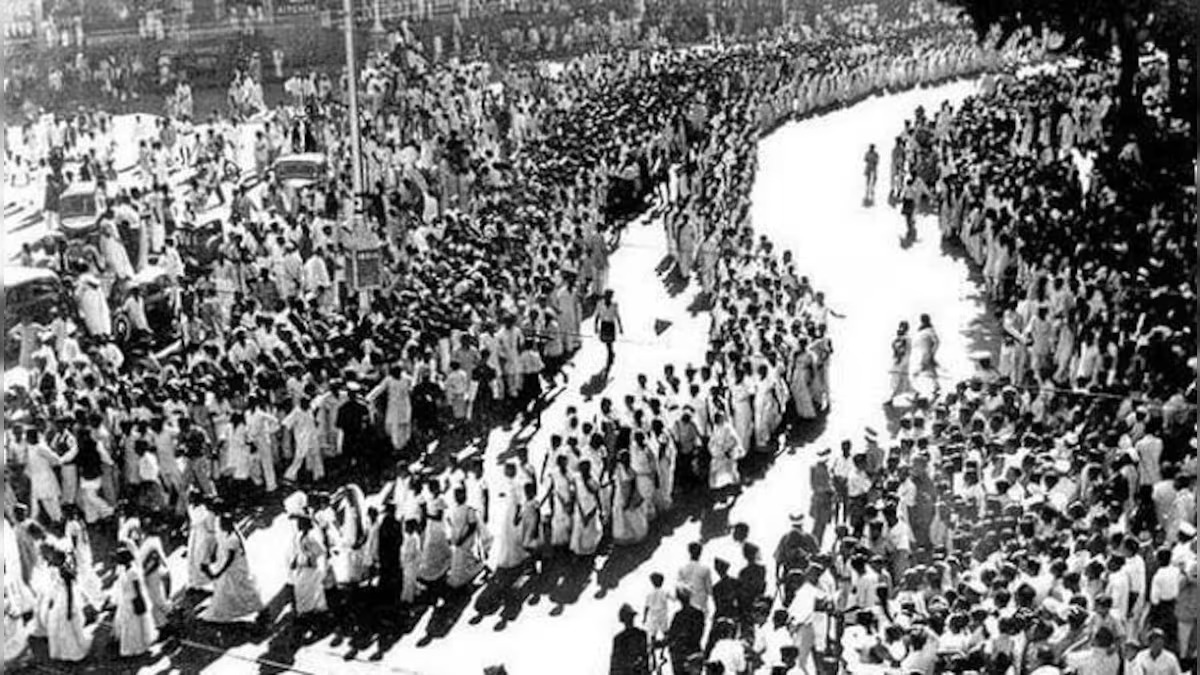Quit India Movement: The Final Push for Indian Independence
History Indian HistoryPosted by NewAdmin on 2025-02-11 09:03:04 |
Share: Facebook | Twitter | Whatsapp | Linkedin Visits: 66

The Quit India Movement, also known as the August Kranti Movement, was a significant phase in India's struggle for independence. It was launched by Mahatma Gandhi and the Indian National Congress on August 8, 1942, at the All-India Congress Committee session in Bombay. The movement was a direct response to the British government's refusal to grant India full independence during World War II and to the failure of previous negotiations, such as the Cripps Mission. Gandhi's call for "Do or Die" encapsulated the urgency and determination of the movement, urging the Indian people to take action against British rule.
The main objective of the Quit India Movement was to demand an immediate end to British colonial rule in India. It aimed at mobilizing the masses across the country to undertake non-violent protests, demonstrations, and civil disobedience. Gandhi believed that if the British were to leave India immediately, the country would be able to self-govern and navigate the challenges of post-colonial life. The Congress Working Committee issued a resolution demanding the withdrawal of the British and calling for the formation of a provisional government of India. The movement was meant to be a mass-based revolt, uniting people from all walks of life in the fight for independence.
The British government responded harshly to the Quit India Movement. Within hours of the movement's launch, Gandhi and other major Congress leaders were arrested and imprisoned. The British also took strict action against the participants of the movement, using military and police force to suppress protests. The movement led to widespread violence and disruptions across the country. However, despite the arrests and repression, the movement spread rapidly, with people across India participating in strikes, protests, and acts of sabotage.
Though the Quit India Movement did not immediately succeed in its goal of ending British rule, it marked a turning point in India's freedom struggle. The movement demonstrated the unity and determination of the Indian masses, showing the British that their control over India was no longer sustainable. The movement also had significant repercussions for the Indian freedom movement, as it led to the mass mobilization of the Indian population and fostered a sense of urgency for independence.
In the years following the Quit India Movement, the British government, unable to contain the growing demand for independence and the economic strain of World War II, began to recognize the inevitability of India's freedom. The Quit India Movement laid the foundation for the final push towards independence, which was achieved in 1947.
Search
Categories
- Sports
- Business
- History
- Politics
- International
- Science & Technology
- Social Issues
- Disaster Management
- Current Affairs
- Education
- Startup Business
- Startup News
- Awards
- Community Services
- Fundraising Events
- Volunteer Services
- Health Initiatives
- Innovations and Initiatives
- In News
- dummybanners
- Awards
- Partners
- Products
- Press Releases
- News
- Fast Check
- South
- సినిమా
- Gallery
- Sunday Chronicle
- Hyderabad Chronicle
- లైఫ్ స్టైల్
- National
- క్రైం
- ట్రెండింగ్
- జాబ్స్
- అంతర్జాతీయo
- బిజినెస్
- రాజకీయం
- బిజినెస్
- సంపాదకీయం
- నవ్య
- చిత్ర జ్యోతి
- క్రీడలు
- జాతీయం
- తెలంగాణ
- తాజా వార్తలు
- మన పార్టీ
- మన నాయకత్వం
- మన విజయాలు
- డౌన్లోడ్స్
- మీడియా వనరులు
- కార్యకర్తలు
- North East Skill Center News
- Government Schemes
- Entrepreneurship Support
- Employment Opportunities
- Skill Training Programs
- Departments
- Investments
- Initiatives
- Resources
- Telangana IT Parks
- Events & Jobs
- Press Releases
- News
- Airport News
- Newtons Laws of Motion
- Karbonn in Business
- Investments in Karbonn
- Company quarterly sales
- Markets
- Auto News
- Industry
- Money
- Advertisements
- Stock target
- Company Updates
- Stock Market
- Company Sales
- Staffing and HR
- Constituency Assembly
- General News
- Srikalahasti Temple
- Bojjala Sudhir Reddy
- Technology & Innovation
- Sports
- Business
- Products
- Industries
- Services & Trainings
- Tools & Resources
- Technology Integration
- Drug Seizures & Arrests
- Telangana Narcotics
- Law & Enforcement
- Rehabilitation
- Nationwide Drug Policing
- Nigeria Seizures
- Global Operations
- Drug Awareness
- Drug Enforcement Tech
- NCB Drug Seizures
- Judicial Crackdown
- India's Surveillance Tools
- Cross-Border Links
- Women Safety
- Cyber Crimes
- Drug Abuse
- Traffic & Road Safety
- Community Connect
- Public Safety Alerts
- Citizen Assistance
- Nellore City News
- Politics & Administration
- Events & Festivals
- Agriculture & Rural
- Business & Economy
- Health & Wellness
Recent News
- Former Vice President Jagdeep Dhankhar Not Yet Requested Official Residence Retainment
- Mopping Up Operations In Lok Sabha, Speaker Om Birla Calls For Introspection
- Last-minute disruptions mark final day of parliament's monsoon session
- Market regulator SEBI plans to extend equity derivatives tenure
- Stock Picks for February: YES Securities & Sharekhan Optimistic About These 5 Companies
- Ban On Real-Money Gaming: 45 Million People Lose Rs 20,000 Crore Each Year, Says Report
- From Porn To Cricket: How Garth Stirrat Rebounds From An Unorthodox Start
- Rift In Saaniya Chandhok's Family? Grandfather Accuses Son of Forgery And Fraud